



Recommendations for restaurants near Cascais with the highest ratings on Tripadvisor.
- Restaurante Indiano: This restaurant is located at Rua Jose Sebastiao de Carvalho e Melo – 15, Cascais, Lisbon, 2750-48. It serves Indian cuisine.
- Baía do Peixe: This restaurant is located at Av. Dom Carlos I 6, Cascais, Lisbon, 2750-6423. It serves seafood.
- Clandestina Taberna – Cantina: This restaurant is located at R. Afonso Sanches 36, Cascais, Lisbon, 2750-4654. It serves a variety of dishes.
- Gusto Pizzeria Da Guia: This restaurant is located in Cascais and is known for its amazing view and delicious food3.
- Seventh Brunch Cascais: This restaurant is located in Cascais and is known for being a very good breakfast place3.
- Malacopa Taco Bar: This restaurant is located in Cascais and serves Mexican cuisine3.
- Ka Sushi Cave: This restaurant is located in Cascais and serves Japanese and seafood cuisine3.
- Sr. Manuel Seafood Bar: This restaurant is located in Cascais and serves bar and seafood cuisine3.
Touch each icon to get the information.
How to get there
To get to Cascais by bus from Lisbon, follow these instructions:
1. Head to one of the following bus stops in Lisbon, from where you can take the bus to Cascais:
– Cais do Sodré: This stop is located in the city center of Lisbon, near the Tagus River. It is one of the main public transport stations in the city and is situated in the Praça Duque da Terceira area.
– Estação de Autocarros Sete Rios: This is another important bus stop in Lisbon, located on Avenida General Norton de Matos in the Sete Rios area.
2. Look for bus number 403. This bus will take you directly to Cascais and is one of the common options to reach there from Lisbon. Make sure to check the updated departure and arrival times, as they may vary depending on the day of the week and the season.
4. Enjoy the journey as the bus takes you along the coast from Lisbon to Cascais. The journey usually takes about 40-60 minutes, depending on traffic and road conditions.
5. When you arrive in Cascais, alight the bus at the designated stop. You will be ready to explore this charming coastal town, with its beautiful beaches, harbor, and lively historic center.
Please note that the following step has been omitted:
3. Skip this step.
The price of the bus ticket for the Lisbon-Cascais route is approximately £3.50.
Comparison of prices and times between bus and train:
– Price: The bus ticket costs around £3.50, while the train ticket from Lisbon to Cascais costs about £2.25.
– Time: The bus generally takes between 40 and 60 minutes to reach Cascais from Lisbon, depending on traffic. On the other hand, the train is usually faster, with a travel time of approximately 30 minutes.
Remember that prices and travel times may vary, so it is advisable to check the updated information before your trip. You can obtain updated information about bus and train schedules, fares, and stops through the website or mobile app of the Lisbon public transport company.
Unfortunately, there is no direct metro connection from Lisbon to Cascais. However, the metro can facilitate your journey by taking you to Cais do Sodré train station, from where you can take the train or bus to Cascais. Below, I will provide instructions from different points on the three metro lines in Lisbon:
Scenario 1: Metro station on the blue line (Linha Azul)
1. If you are at a station on the blue line of the Lisbon metro, head towards Cais do Sodré on the same line.
2. Once at Cais do Sodré, exit the metro station and look for the train station or corresponding bus stop.
3. From there, you can take the train or bus to Cascais.
Scenario 2: Metro station on the green line (Linha Verde) or yellow line (Linha Amarela)
1. If you are at a station on the green or yellow line of the Lisbon metro, transfer at a station that connects to the blue line.
2. Take the blue line towards Cais do Sodré.
3. Upon reaching Cais do Sodré, exit the metro station and look for the train station or corresponding bus stop.
4. From there, you can take the train or bus to Cascais.
Scenario 3: Metro station on the red line (Linha Vermelha)
1. If you are at a station on the red line of the Lisbon metro, transfer at a station that connects to the blue line.
2. Take the blue line towards Cais do Sodré.
3. Upon reaching Cais do Sodré, exit the metro station and look for the train station or corresponding bus stop.
4. From there, you can take the train or bus to Cascais.
Please remember to check train and bus schedules, as well as the exact location of the stops, as changes or updates may occur. You can obtain updated information about train and bus schedules and routes through the websites or mobile apps of the respective public transport companies.

Above in the photo gallery you will find the map in real size.
To get to Cascais by train from Lisbon, follow these instructions:
1. Head to Cais do Sodré train station, which is conveniently located near the popular tourist areas in Lisbon. It’s very easy to reach, especially if you’ve visited the famous Praça do Comércio, which is one of the most important landmarks in the city and attracts a large number of tourists.
2. From Praça do Comércio, walk north towards the Tagus River. You’ll see Cais do Sodré train station within a short distance, approximately about 500 meters away.
3. Upon reaching Cais do Sodré train station, look for the information boards displaying the train schedules for Cascais.
4. Check the departure times and make sure to board the correct train heading to Cascais. Trains usually operate at regular intervals throughout the day.
5. Enter the train and find an available seat. Ensure you have a valid train ticket before boarding. You can purchase tickets at the station ticket counters or by using the ticket vending machines.
6. Enjoy the picturesque train journey as you travel along the coast towards Cascais. The train ride from Cais do Sodré to Cascais typically takes around 30 minutes.
7. Upon arriving at Cascais train station, alight from the train and you’ll be ready to explore this charming coastal town with its beautiful beaches, waterfront promenades, and stunning scenery.
Remember to check the updated train schedules as they may vary depending on the season and the day of the week. Also, note that ticket prices may change, so it’s advisable to consult the latest information before your trip.
Once you arrive at the site, listen to a brief explanation of the history of the place.
- Audio in English
- Audio en français
- Audio en Español
- Audio auf Deutsch




Choose Your Language.
- Reading in English
- Lire en Français
- Lectura en Español
- Lesen auf Deutsch
Cascais is known for its picturesque coastline and dreamy beaches. Here are some of the top beaches you shouldn’t miss:
1. Guincho Beach: Located west of Cascais, Guincho Beach is famous for its natural beauty and being a paradise for surfers and windsurfers. Its extensive dunes and wild environment make it a unique beach.
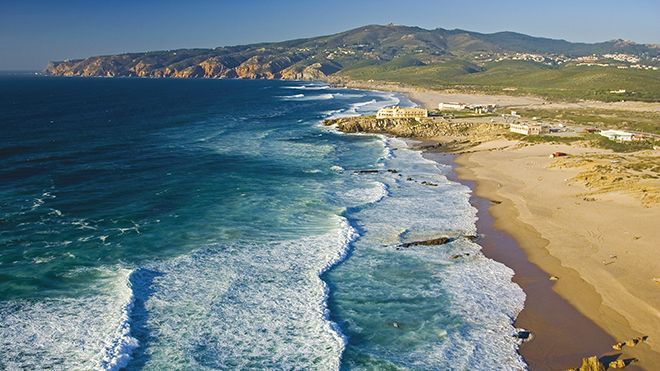
2. Carcavelos Beach: Situated just a few kilometers from Cascais, Carcavelos Beach is one of the most popular in the area. Its calm waters and wide golden sand make it an ideal place to enjoy a sunny day by the sea.
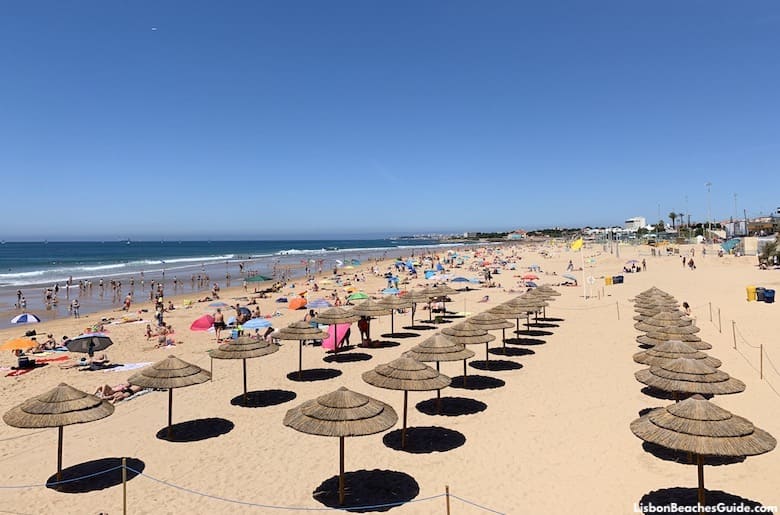
3. Tamariz Beach: This charming beach is in the heart of Estoril, a neighboring town to Cascais. Tamariz Beach is known for its lively atmosphere and numerous restaurants and bars along its promenade. It’s a perfect place to relax and enjoy the views of the Atlantic Ocean.
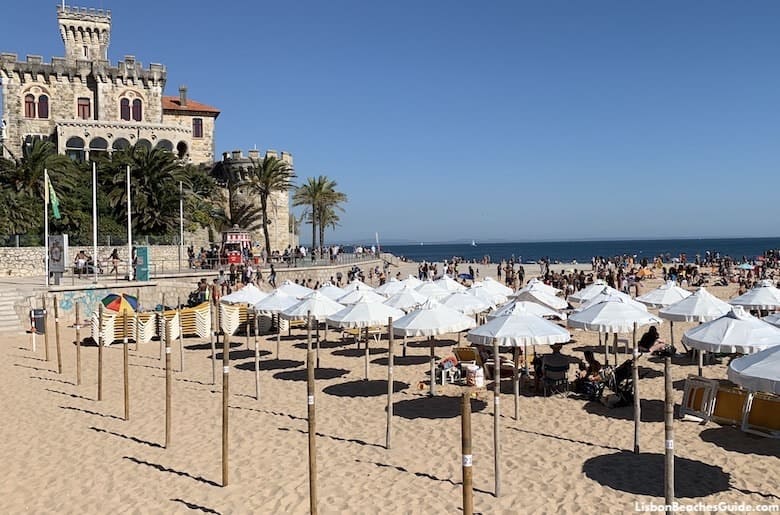
In addition to its beaches, Cascais has several tourist attractions and a rich history. Here are some highlights:
1. Cascais Historic Center: The historic center of Cascais is charming, with its cobbled streets, colorful buildings, and picturesque squares. Strolling through its streets will allow you to discover local shops, cozy restaurants, and the Church of Nossa Senhora da Assunção, built in the 16th century.
2. Condes de Castro Guimarães Museum: This museum is located in a beautiful palace overlooking the sea. It houses a valuable collection of art and historical objects. It’s worth a visit to learn more about the history of the region.
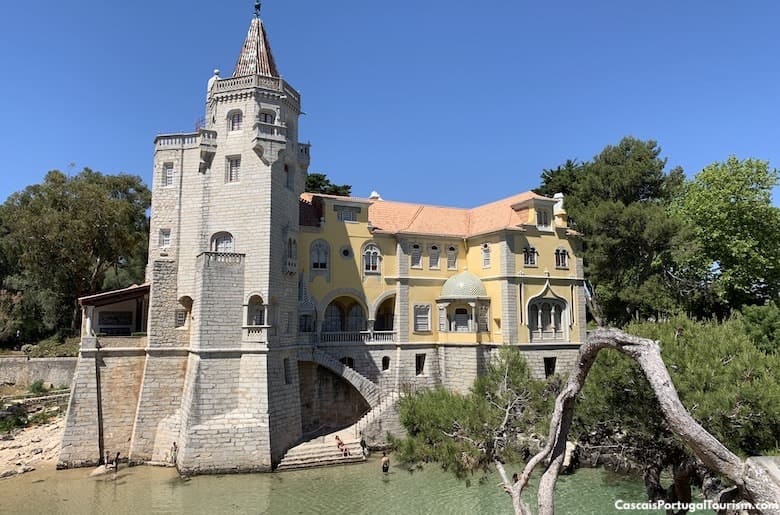
3. Boca do Inferno: Located near the center of Cascais, Boca do Inferno is an impressive rock formation. During high tides, the waves crash forcefully against the rocks, creating a stunning natural spectacle. It’s a very photogenic spot and a must-visit.

Regarding the history of Cascais, it was once a small fishing village that became a summer retreat for the Portuguese nobility and bourgeoisie in the 19th century. During World War II, Cascais became a refuge for many European exiles. This diverse and rich history is reflected in the architecture and culture of the city.
I hope this information is helpful for you to enjoy your visit to Cascais. Enjoy the beaches, the tourist attractions, and the fascinating history of this charming coastal city in Portugal!
Cascais est connue pour sa côte pittoresque et ses plages de rêve. Voici quelques-unes des meilleures plages à ne pas manquer :
1. Plage de Guincho : Située à l’ouest de Cascais, la plage de Guincho est célèbre pour sa beauté naturelle et son paradis pour les surfeurs et les véliplanchistes. Ses vastes dunes et son environnement sauvage en font une plage unique.
2. Plage de Carcavelos : Située à quelques kilomètres de Cascais, la plage de Carcavelos est l’une des plus populaires de la région. Ses eaux calmes et son sable doré étendu en font un endroit idéal pour profiter d’une journée ensoleillée au bord de la mer.
3. Plage de Tamariz : Cette charmante plage se trouve au cœur d’Estoril, une ville voisine de Cascais. La plage de Tamariz est réputée pour son ambiance animée et ses nombreux restaurants et bars le long de sa promenade. C’est un endroit parfait pour se détendre et profiter de la vue sur l’océan Atlantique.
En plus de ses plages, Cascais possède plusieurs attractions touristiques et une riche histoire. Voici quelques points forts :
1. Centre historique de Cascais : Le centre historique de Cascais est charmant, avec ses rues pavées, ses bâtiments colorés et ses places pittoresques. En vous promenant dans ses rues, vous découvrirez des boutiques locales, des restaurants confortables et l’église de Nossa Senhora da Assunção, construite au XVIe siècle.
2. Musée Condes de Castro Guimarães : Ce musée est situé dans un magnifique palais surplombant la mer. Il abrite une précieuse collection d’art et d’objets historiques. Il vaut la peine d’être visité pour en apprendre davantage sur l’histoire de la région.
3. Boca do Inferno : Située près du centre de Cascais, Boca do Inferno est une impressionnante formation rocheuse. Lors des marées hautes, les vagues s’écrasent violemment contre les rochers, créant un spectacle naturel époustouflant. C’est un endroit très photogénique et à ne pas manquer.
Quant à l’histoire de Cascais, c’était autrefois un petit village de pêcheurs devenu une destination estivale pour la noblesse et la bourgeoisie portugaise au XIXe siècle. Pendant la Seconde Guerre mondiale, Cascais est devenu un refuge pour de nombreux exilés européens. Cette histoire diverse et riche se reflète dans l’architecture et la culture de la ville.
J’espère que ces informations vous seront utiles pour profiter de votre visite à Cascais. Profitez des plages, des attractions touristiques et de l’histoire fascinante de cette charmante ville côtière au Portugal !
Cascais es conocido por su pintoresca costa y sus playas de ensueño. Aquí hay algunas de las mejores playas que no debes perderte:
1. Playa de Guincho: Ubicada al oeste de Cascais, la playa de Guincho es famosa por su belleza natural y por ser un paraíso para los surfistas y windsurfistas. Sus extensas dunas y su entorno salvaje la convierten en una playa única.
2. Playa de Carcavelos: Situada a pocos kilómetros de Cascais, la playa de Carcavelos es una de las más populares de la zona. Sus aguas tranquilas y su amplia extensión de arena dorada la convierten en un lugar ideal para disfrutar de un día soleado junto al mar.
3. Playa de Tamariz: Esta encantadora playa se encuentra en el corazón de Estoril, una ciudad vecina de Cascais. La playa de Tamariz es conocida por su ambiente animado y por sus numerosos restaurantes y bares a lo largo de su paseo marítimo. Es un lugar perfecto para relajarse y disfrutar de las vistas al océano Atlántico.
Además de sus playas, Cascais cuenta con varios atractivos turísticos y una rica historia. Aquí hay algunos lugares destacados:
1. Centro Histórico de Cascais: El centro histórico de Cascais es encantador, con sus calles empedradas, edificios coloridos y plazas pintorescas. Pasear por sus calles te permitirá descubrir tiendas locales, restaurantes acogedores y la Iglesia de Nossa Senhora da Assunção, construida en el siglo XVI.
2. Museo Condes de Castro Guimarães: Este museo se encuentra en un hermoso palacio con vistas al mar. Alberga una valiosa colección de arte y objetos históricos. Vale la pena visitarlo para conocer más sobre la historia de la región.
3. Boca do Inferno: Ubicada cerca del centro de Cascais, Boca do Inferno es una impresionante formación rocosa. Durante las mareas altas, las olas golpean con fuerza contra las rocas, creando un espectáculo natural impresionante. Es un lugar muy fotogénico y una visita obligada.
En cuanto a la historia de Cascais, fue una pequeña aldea de pescadores que se convirtió en un lugar de veraneo para la nobleza y la burguesía portuguesa en el siglo XIX. Durante la Segunda Guerra Mundial, Cascais se convirtió en un refugio para muchos exiliados europeos. Esta historia diversa y rica se refleja en la arquitectura y la cultura de la ciudad.
Espero que esta información te sea útil para disfrutar de tu visita a Cascais. ¡Disfruta de las playas, los atractivos turísticos y la fascinante historia de esta encantadora ciudad costera en Portugal!
Willkommen in Cascais, einem wunderschönen Touristenziel in Portugal! Lassen Sie mich Ihnen von den besten Stränden in Cascais, ihren Hauptattraktionen und etwas von ihrer Geschichte erzählen.
Cascais ist bekannt für seine malerische Küste und traumhafte Strände. Hier sind einige der Top-Strände, die Sie nicht verpassen sollten:
1. Guincho Strand: Der Guincho Strand liegt westlich von Cascais und ist berühmt für seine natürliche Schönheit und als Paradies für Surfer und Windsurfer. Seine ausgedehnten Dünen und die wilde Umgebung machen ihn zu einem einzigartigen Strand.
2. Carcavelos Strand: Nur wenige Kilometer von Cascais entfernt liegt der Carcavelos Strand, einer der beliebtesten in der Gegend. Sein ruhiges Wasser und der breite goldene Sand machen ihn zu einem idealen Ort, um einen sonnigen Tag am Meer zu genießen.
3. Tamariz Strand: Dieser charmante Strand liegt im Herzen von Estoril, einer benachbarten Stadt von Cascais. Der Tamariz Strand ist für seine lebhafte Atmosphäre und die zahlreichen Restaurants und Bars entlang der Promenade bekannt. Es ist ein perfekter Ort, um zu entspannen und die Aussicht auf den Atlantischen Ozean zu genießen.
Neben den Stränden hat Cascais mehrere touristische Attraktionen und eine reiche Geschichte. Hier sind einige Höhepunkte:
1. Historisches Zentrum von Cascais: Das historische Zentrum von Cascais ist charmant mit seinen gepflasterten Straßen, bunten Gebäuden und malerischen Plätzen. Ein Spaziergang durch die Straßen ermöglicht es Ihnen, lokale Geschäfte, gemütliche Restaurants und die Kirche Nossa Senhora da Assunção aus dem 16. Jahrhundert zu entdecken.
2. Condes de Castro Guimarães Museum: Dieses Museum befindet sich in einem wunderschönen Palast mit Blick auf das Meer. Es beherbergt eine wertvolle Sammlung von Kunst und historischen Objekten. Ein Besuch lohnt sich, um mehr über die Geschichte der Region zu erfahren.
3. Boca do Inferno: In der Nähe des Zentrums von Cascais befindet sich Boca do Inferno, eine beeindruckende Felsformation. Bei Flut prallen die Wellen mit großer Kraft gegen die Felsen und schaffen ein atemberaubendes Naturschauspiel. Es ist ein sehr fotogener Ort und ein Muss für einen Besuch.
Was die Geschichte von Cascais betrifft, war es einst ein kleines Fischerdorf, das im 19. Jahrhundert zum Sommerrefugium für den portugiesischen Adel und die Bourgeoisie wurde. Während des Zweiten Weltkriegs wurde Cascais zum Zufluchtsort vieler europäischer Exilanten. Diese vielfältige und reiche Geschichte spiegelt sich in der Architektur und Kultur der Stadt wider.
Ich hoffe, diese Informationen helfen Ihnen, Ihren Besuch in Cascais zu genießen. Genießen Sie die Strände, die touristischen Attraktionen und die faszinierende Geschichte dieser charmanten Küstenstadt in Portugal!

Closest Nearby Destination: Discover the Next Stop from Here
Related products
-

Monument To The Discoveries: Celebrating Portugal’s Age Of Exploration And Adventure
- Lisboa, Architecture, Historic Sites, Historical Monuments, Landmarks, Museums and Art Galleries, Places
-
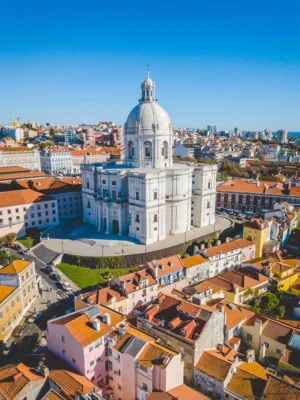
The National Pantheon of Lisbon: Exploring Historical and Cultural Grandeur
-
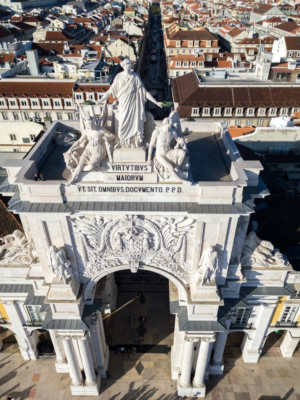
Arco de Rua Augusta (Rua Augusta Arch) – Lisbon’s Triumphal Arch
-

Exploring the Grandeur of Pena National Palace: A Journey into the Heart of Architectural Romanticism




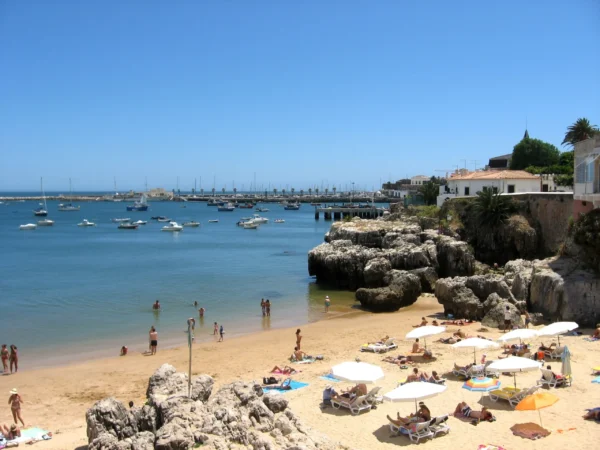

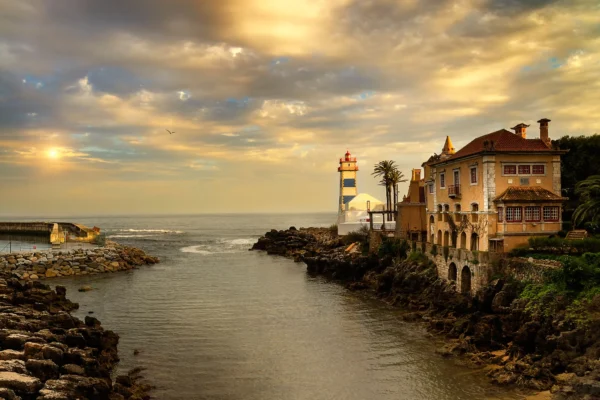
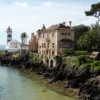
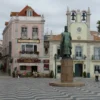
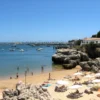

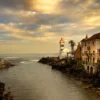



Reviews
There are no reviews yet.